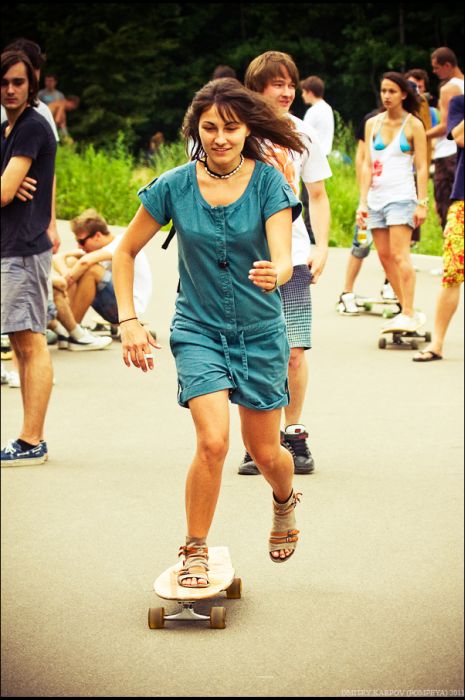|
|
Skateboarding Girl
|
The first manufactured skateboards were ordered by a Los Angeles, California surf shop, meant to be used by surfers in their downtime. The shop owner, Bill Richard, made a deal with the Chicago Roller Skate Company to produce sets of skate wheels, which they attached to square wooden boards. Accordingly, skateboarding was originally denoted "sidewalk surfing" and early skaters emulated surfing style and maneuvers. Crate scooters preceded skateboards, and were borne of a similar concept, with the exception of having a wooden crate attached to the nose (front of the board), which formed rudimentary handlebars.
A number of surfing manufacturers such as Makaha started building skateboards that resembled small surfboards, and assembling teams to promote their products. The popularity of skateboarding at this time spawned a national magazine, Skateboarder Magazine, and the 1965 international championships were broadcast on national television. The growth of the sport during this period can also be seen in sales figures for Makaha, which quoted $10 million worth of board sales between 1963 and 1965 (Weyland, 2002:28). Yet by 1966 the sales had dropped significantly (ibid) and Skateboarder Magazine had stopped publication. The popularity of skateboarding dropped and remained low until the early 1970s.
• The 1970s
In the early 1970s, Frank Nasworthy started to develop a skateboard wheel made of polyurethane, calling his company Cadillac Wheels. Prior to this new material, skateboards wheels were metal or "clay" wheels. The improvement in traction and performance was so immense that from the wheel's release in 1972 the popularity of skateboarding started to rise rapidly again, causing companies to invest more in product development. Nasworthy commissioned artist Jim Evans to do a series of paintings promoting Cadillac Wheels, they were featured as ads and posters in the resurrected Skateborder magazine, and proved immensely popular in promoting the new style of skateboarding. Many companies started to manufacture trucks (axles) specially designed for skateboarding, reached in 1976 by Tracker Trucks. As the equipment became more maneuverable, the decks started to get wider, reaching widths of 10 inches (250 mm) and over, thus giving the skateboarder even more control. Banana board is a term used to describe skateboards made of polypropylene that were skinny, flexible, with ribs on the underside for structural support and very popular during the mid-1970s. They were available in myriad colors, bright yellow probably being the most memorable, hence the name.
|
|









